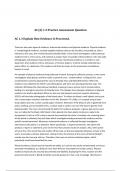AC (3) 1.3 Practice Assessment Question
AC 1.3 Explain How Evidence Is Processed.
There are two main types of evidence, testimonial evidence and physical evidence. Physical evidence
is ‘morphological evidence’, actually tangible evidence that can be touched, and picked up, that is
relevant to this case, this involves blood and bodily fluids. Crime Scene Investigators collect physical
evidence from a crime scene, and maintain a proper chain of custody of that evidence. CSI’s also take
photographs and physical measurements of the area. Testimonial evidence is a written or oral
statement, that could be victims, witnesses, or forensic experts. It will be initially collected by a
police officer or a detective. This evidence will then be shown to the prosecution and defence
lawyers in court.
An example of physical evidence being collected is blood. During the collection process, crime scene
investigators wear glasses and face masks to prevent cross - contamination. Linking to this, cross
contamination severely impacted the case of Amanda Knox and Meredith Kercher. When the
evidence was collected, the SOCO’s used dirty gloves and were not wearing protective caps. The
collection fell below the international standard, meaning it was a serious risk of contamination,
leading to a wrongful conviction of Amanda Knox. This displays how improper collection of physical
evidence can lead to significant effects on the case and pinpoint incorrect suspects. Moreover,
SOCO’s will also take photographs of the blood stains. To collect dry blood, small objects can be put
into a clean paper container and taken to the lab. However if it’s flaky, it is scraped using a clean
sharp object also into a clean unused paper container. Moreover, if the blood is wet or gathered from
pools, clothing, and unmovable items, a cotton swab is used to run over the stain to get the most
blood possible. The more concentrated the better for evidence purposes. A gauze pad can be used
too, as it absorbs the blood. Wet blood is then placed into clean plastic containers ready to be
transported. A role of a CSI is also to ensure they maintain the chain of custody rule, meaning when
all the blood is collected, they will state which investigative body processed the evidence and the
specific named personnel. Moreover, testimonial evidence is collected through investigative
interviews by the police or a detective. More specifically, in expert testimonies, the expert will
produce a report or statement, prior to the trial that contains results of analysis. Also, when police
arrive at the crime scene they will cordon off the area, so that any potential witnesses remain at the
scene, to provide a witness statement. Linking to this, the witness at the scene of Rachel Nickell’s
murder was her two year old son. Therefore, there was no witness statement given, which
potentially could have benefited the case.
Physical evidence, blood must be transferred safely, as it can be very easily contaminated, and must
be tested immediately, as a delay of more than 48 hours may make the sample useless. Physical
evidence should also be securely documented and labelled, displaying the time, location and the
personnel who found it. Blood should be securely packed as it has a risk of spillage. Wet blood is




